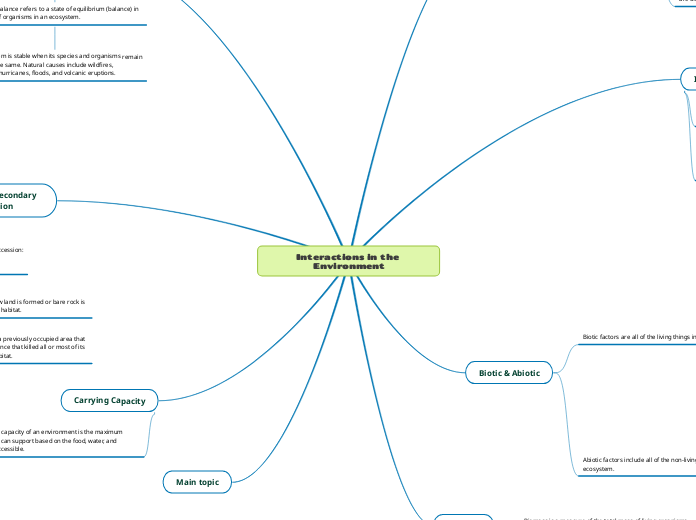Interactions in the Environment
Main topic
Carrying Capacity
The carrying capacity of an environment is the maximum population it can support based on the food, water, and resources accessible.
Primary vs. Secondary
Succession
There are two types of ecological succession:
Primary Succession
Secondary Succession
Secondary Succession:
Secondary succession is when a previously occupied area that has been affected by a disturbance that killed all or most of its community is remade into a habitat.
Primary Succession:
Primary succession is when new land is formed or bare rock is revealed, creating a place for a habitat.
Ecological Balance
Ecological balance refers to a state of equilibrium (balance) in the group of organisms in an ecosystem.
An ecosystem is stable when its species and organisms remain relatively the same. Natural causes include wildfires, tornadoes, hurricanes, floods, and volcanic eruptions.
Biomass
Biomass is a measure of the total mass of living organisms within an ecosystem.
A Biomass Pyramid is used to graph the energy transfer between organisms
Biotic & Abiotic
Abiotic factors include all of the non-living things in an ecosystem.
Some examples of Abiotic factors are:
* Sunlight
* Rocks
* Rivers
* Wind
* Temp
* Dirt
Biotic factors are all of the living things in an ecosystem.
All living things:
* Are able to grow
* Move
* Use nutrients
* Reproduce
* Produce waste
* Require oxygen
Some examples of Biotic factors are:
* Frogs
* Plants
* Insects
* Mushrooms
* Snails
Biotic factors are divided into three categories:
Detritivores (decomposers)
organisms that break down chemicals from producers into simpler forms so that they can be reused.
Heterotrophs (consumers)
organisms that can't create their own food. Instead, they rely on other organisms like plants and animals for food.
Autotrophs (producers)
organisms that produce their own food.
Invasive Species
Some examples of invasive species invading a new ecosystem are:
* An insect getting trapped in a shipping crate
* An aquatic species attaching to a boat.
* People bringing wild animals as "pets" to a new location
An invasive species is a living thing that is brought to a new habitat, often causing damage to the new environment.
Carnivores, Herbivores & Omnivores.
Herbivores:
animals that only eat plants. Some examples of herbivores are deer, rabbits, squirrels, and cows.
Carnivores:
animals that only eat meat from other animals. Some examples of carnivores are lions, tigers, owls, snakes, and spiders.
Omnivores:
animals that eat both plants and animal meat. Some examples of omnivores are raccoons, mice, squirrels, bears, and humans.









